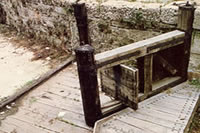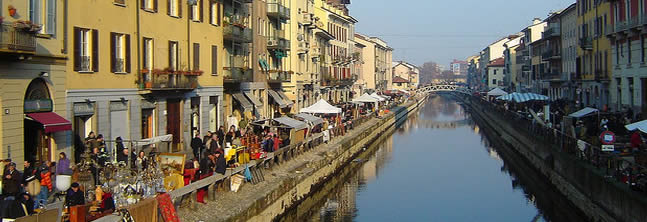If Leonardo hypothetically could see the Navigli today, he would surely be much surprised but probably he would just join in the Milanese for a drink sitting by the canals, maybe already drawing a mental plan to improve the functionality and outlook of this entertainment district. Understanding the movement of water and the rules of hydraulic was in fact, one of Leonardo’s great passions, as confirmed by the wealth of original drawings on the subject.

Navigli's sluice door near Brera
In 1100s Milan had already developed a circular moat system used for irrigation purposes and to operate hydraulic wheels to mill the wheat, cut woods etc. When Leonardo arrived in the city he started working on ways to improve this canal system which was becoming increasingly pivotal for the economic development of Milan. He started first by studying the existing system as confirmed by many drawings and notes referring to Milan’s waterways. For example about the Naviglio Martesana, connecting the city with the river Adda, Leonardo wrote “[…] when the Martesana Canal was made, this diminished the waters of the Adda, which are now distributed throughout many villages, in service of the fields.” On the resistance of the canal banks he noted: “No canal that flows out of rivers will last if the water of the river from which it arises is not completely enclosed, as in the Martesana Canal and the one that flows out of the Ticino [the Naviglio Grande].”
Despite the fact that Leonardo was not personally involved with the construction of the Navigli, he left many sketches and notes about his ideas which were adopted later by other engineers who worked on the canal system.
The Navigli today
In the 19th century the canals started to be covered and replaced with roads as the invention of combustion engine made transport on rail and roads more attractive. Today only three canals have survived. The Naviglio Grande e Naviglio Pavese are the centre of the city’s nightlife especially during the warmest months of the year when Milanese enjoy sitting along the canal and sipping a glass of wine. The Naviglio Martesana is used instead by weekend cyclists who can follow the canal all the way to the river Adda about 30 km away.
Did you know?
Milan was once Italy's fourth largest port after Genoa, Venice and Naples.



